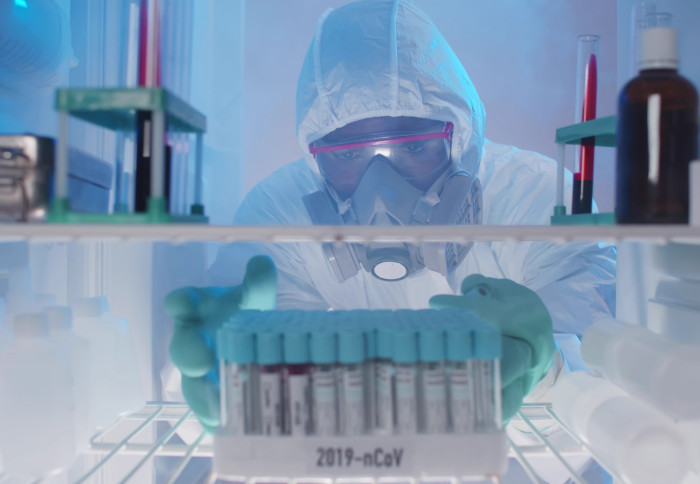Q&A: Cold chains, COVID-19 vaccines and reaching low-income countries

Many low-income countries lack the infrastructure to deliver vaccines effectively, so how can we ensure COVID-19 vaccines are accessible for all?
As COVID-19 vaccine candidates begin to show promising trial results, and as the Pfizer mRNA vaccine is approved for use in the UK, many are cautiously optimistic that they could hold the key to lower infection rates, fewer deaths, and at least a partial return to normalcy.

However, many lower income countries lack the infrastructure and resources needed to distribute potential vaccines safely – with extra logistical challenges for vaccines stored at extremely cold temperatures – which could leave their populations just as vulnerable to COVID-19 as before.
Professor Jason Hallett, of Imperial’s Department of Chemical Engineering and Future Vaccine Manufacturing Research Hub, wants to make vaccines accessible for all. His research group is working on eliminating the need for high-maintenance infrastructure like cold chains, which means adapting vaccines themselves to be able to withstand a wider variety of temperatures.
What is meant by vaccine ‘cold chains’ and why are they important?
Vaccines are based on biomolecules which are usually highly unstable outside their native environments. This means they can quickly lose potency or become toxic, resulting in ruined batches if not stored correctly.
Proper storage for vaccines often means keeping them very cold, at refrigerator temperature (2 – 8°C) or sometimes as low as -80°C, throughout the supply and distribution chain - from manufacturing all the way to administering them to patients. This (sometimes literal) chain of freezers in which the vaccines are stored is commonly referred to as the ‘cold chain’.
The new Pfizer vaccine, for example, needs to be stored at around -70°C and will be transported in boxes packed in dry ice. Once delivered, it can be kept for up to five days in a fridge.
What kinds of challenges arise during vaccination programmes?
Resource-limited areas with little or no refrigeration facilities will be unable to benefit fully from the vaccines. Professor Jason Hallett Department of Chemical Engineering
Vaccination programmes are expensive, and this is due mainly to the cold chain, which costs $200–300 million per year and can account for up to 80 per cent of overall vaccination costs.
Some of the COVID-19 vaccines currently in development require ultra-cold storage (temperatures below -80°C) which means they will be extremely challenging to administer safely in remote parts of the globe as they are far away from major transport links. This will be particularly true in resource-limited countries that lack cold storage infrastructure or have remote populations far from major cities, making vaccine programmes prohibitively expensive.
The most important challenges to effective cold chains are poor temperature control and maintenance leading to the reduced potency of vaccines, inadequate availability of vaccines due to insufficient cold chain capacity, and a lack of the latest cold storage technology. This is especially difficult during transport and storage, as portable freezers have limited running times, and very remote areas do not have access to cold storage.
Fortunately, not all future COVID-19 vaccines will require the cold chain, but many of the current candidates do. As a result, resource-limited areas with little or no refrigeration facilities will be unable to benefit fully from the vaccines.
How can we tackle these hurdles?
New RNA vaccines can provide outstanding speed and manufacturing cost benefits, but they mean we must now re-address the cold storage challenge as they still require robust cold chains. Professor Jason Hallett Department of Chemical Engineering
Our approach is to eliminate the cold chain altogether by making vaccines that can withstand more natural temperatures. We hope this will circumvent the issues cold chains cause for developing countries and throughout the world. We have focused on two aspects of vaccine storage – one approach for protein-based vaccines and a separate approach for RNA or DNA-based vaccines.
The goal is to create approaches to vaccine stabilisation that can enable indefinite vaccine storage. This would move vaccine stability at elevated (outdoor summer) temperatures and humidity from the time scale of hours to months or years.
Many researchers have been working on producing these types of vaccines, and companies have adopted approaches that use additives to increase storage and thermal stability. This has helped many vaccines move from the ‘deep freeze’ of -80 °C to the refrigerator-friendly 2–8°C range. While this greatly reduces the impact of vaccine instability during transport, it doesn’t fully address vaccine inaccessibility in areas with unreliable electricity and local transportation.
More recent approaches have tried to move away from complex vaccine mixtures to try to improve storage stability. This has resulted in several protein-based vaccines being able to withstand room-temperature storage.
However, next-generation vaccines, including the new Pfizer COVID-19 vaccine, are based on RNA. These vaccines can provide outstanding speed and manufacturing cost benefits, but they mean we must now re-address the cold storage challenge as they still require robust cold chains.
How close are you to meeting your goal, and what’s next for your research?
We’re very close to meeting our goal. We have developed some in-house formulations for RNA vaccines that are stable at room temperature. These formulations would not require any cold storage during their service lifetime, and potentially could be manufactured and distributed today, using safe ingredients.
We are continuing our performance testing, but early indications are that there are positive effects on vaccine potency also. Our next steps are to expand the range of treatments and delivery options for which these formulations will work.
Watch Professor Jason Hallett present his work to world leaders at the World Economic Forum.
Article text (excluding photos or graphics) © Imperial College London.
Photos and graphics subject to third party copyright used with permission or © Imperial College London.
Reporter
Caroline Brogan
Communications Division